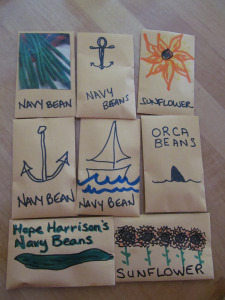I had the pleasure of attending a youth engagement event in Amherst recently, which was organized by the Community Sector Council of NS (http://csc-ns.ca/). The CSC partnered with the Heartwood Centre for Community Youth Development (http://heartwood.ns.ca/ ) to host this event.
I was invited to do a gardening workshop, which isn’t always easy this time of the year. Luckily, I had a pile of dried sunflower heads and some unshelled white (navy) beans from my garden handy, so I decided to do a seed cleaning exercise.
As part of the seed workshop, I demonstrated a simple winnowing technique for removing seeds from the chaff. Using recycled pie plates and a seed catalogue to act as a “fan”, students transferred seeds back and forth from one plate to the next while making a fanning motion with the booklet, until the chaff was blown away, leaving clean seeds behind. Undoubtedly it is a messy activity for the indoors, but that was part of the joy of it. Ideally, you would use nature (wind) to do your winnowing!
While the group was seed threshing, I relayed a story about where the navy beans originated and the participants seemed really intrigued. I told them how they came from farmer friend of mine, who had been saving them for many decades from her garden, until recently moving into a retirement home. Her family relied on these seeds for many winters, and they were traded among her neighbours for several years. These beans, also as “Saturday Night Baked Beans”, became a staple for many from my friend’s generation, probably because of their versatility and the fact that they grow so well in our cool climate and the short growing season. I think everyone appreciated this bit of folklore – a story about passing something on from one generation to the next, which is so important to our food security.

Above: MickeyMickey Williams (Left) and Rachel St. Jean (Right) are in the final stages of the seed cleaning adventure – removing any remaining chaff by hand).
The workshop included an artsy component as well, in which participants were asked to decorate seed packets, to fill with all of the seeds they had cleaned. I brought old seed catalogues, and a supply of scissors, glue and markers were on hand and this, along with some serious creativity, helped us to fashion some great packaging!
Even though the group was small (most likely due to the harsh winter weather we have been experiencing), we managed to accomplish a lot, and have a lot of fun while doing so! The group whipped up over 50 seed packets in about an hours time. The students took some of the seed packets home with them and the remainder were donated to the upcoming Amherst Seed Exchange, which is taking place on Sat. March 7, 1-3 pm at the YMCA of Cumberland. http://cumberlandfoodactionnetwork.ca/
Prior to the hands-on component of the workshop, I was invited to sit in the youth’s circle and we talked about what our favourite veggies were and why seed saving is so important. Among the reasons we came up with included saving money, encouraging local food biodiversity, selecting for your favourite veggie traits, and resisting the growing corporate control of seeds (a la Monsanto). Of course because seed saving is so much fun was also mentioned! For more on “why save seeds” see: http://www.seeds.ca/diversity
Turns out there was a lot of green thumbs in the audience, and many who had saved seeds before. I was impressed to say the least. Just like seeds do, these young folks give me hope for the future!
Lastly, the story of my experience would not be complete without mentioning the awesome food catered by The Art of Eating Deli (https://www.facebook.com/ArtofEatingNS). Art of Eating is one of a growing number of local food restaurants in the County and boasts some of the finest meals going. They put on a luxurious spread for us all and we were all really grateful for the tasty abundance. As an aside, the cafe is currently employing a young farmer in her off season, which I also think is really cool.
All in all, I am so happy that I had the chance to participate in the day, and want to say thanks again to Wendy Johnston of the CSC and Brian Braganza of Heartwood, for organizing the event, and for the invite. Many thanks to the youth for welcoming me so warmly into their circle. There is talk of more workshops taking place in Amherst in the future, which I look forward to being a part of.
Blog by: Su Morin, Ecology Action Centre, Our Food Project – Community Food Coordinator for Cumberland County, NS.
Featured photo courtesy of Hope Harrison, whose hands are seen holding her heritage navy beans.





